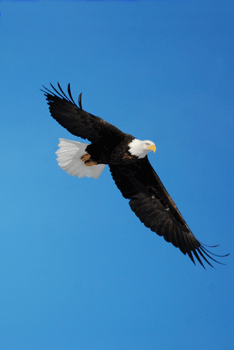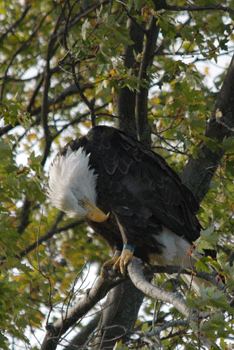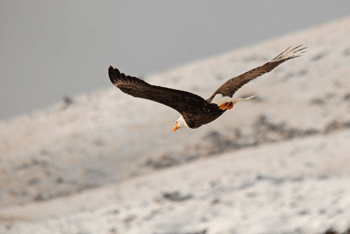Nature/Wildlife
Bald Eagle: The Bird Behind the Symbol
(c) Jack Ballard

Best known in our nation as a symbol of the United States, likenesses of the bald eagle appear on most official seals and have also appeared on the backs of many coins. The bald eagle is our national bird. However, it’s a species whose name doesn’t seem to fit the creature. After all, the head of an adult bald eagle is clad in feathers, not devoid of covering as the term “bald” implies.
However, when these eagles were first named, the word “bald” was commonly understood as a shorter version of “piebald” which referred to someone with a white head of hair rather than a head lacking hair. Thus, the bald eagle’s name perfectly fits it appearance when considered against the vocabulary of early America. For the pioneers who encountered them, bald eagles were considered “white-headed eagles,” based on the meaning of their name.

Although their striking hoary heads and matching tail feathers are the trademark features of these magnificent birds, not all bald eagles exhibit them. Young eagles do not attain this pale plumage on the head and tail until they reach reproductive maturity, usually at four or five years of age. Prior to this time, their appearance exhibits varying stages of development. For the first year or two, bald eagles are brown, showing little or no white on their heads and tail feathers and are easily confused with young golden eagles. Junior members of both species exhibit white mottling on their bodies and undersides of their wings. Around three years of age, bald eagles begin to acquire their trademark white head and tail, although brown streaking is common on both.
Distinguishing immature bald eagles from all golden eagles is a challenge, but attention to a few unique markings will do the trick if you have time to study a bird through binoculars or at close range. Golden eagles have feathers on their legs extending all the way to their toes while the large, yellow legs of the bald eagle do not have feathers on the lower parts. Bald eagles also exhibit a blockier head and slightly shorter tail than golden eagles. In most habitats in the contiguous United States, golden eagles are also noticeably larger than their bald cousins.
Although immature birds can be very difficult to distinguish in the field, bald and golden eagles are unrelated, save for their name. In fact, the term “eagle” is somewhat confusing in itself. For eagles are no more than oversized raptors that could well be called “hawks.” Several species of “eagles” in Europe are smaller than the red-tailed hawks of North America. Taxonomically, bald eagles are aligned with the broader family of sea-eagles (haliaeetus) which include the white-tailed eagle of Greenland and Eurasia, and the mighty Stellar’s sea-eagle of northeastern Asia, a species occasionally see on Alaska’s Aleutian Islands. Golden eagles are part of the family of “true eagles” (aquila), distinguished by fully-feathered legs. The wedge-tailed eagle of Australia shares this family with the golden eagle, similar in size and color, but with noticeably longer necks and legs.
The differing families of the bald and golden eagles also originates in their feeding habits. Bald eagles are seldom found far from water, and are enthusiastic consumers of fish, whether taken on their own or usurped from ospreys. They’re also very prone to dine upon carrion, especially in the winter months when road-killed deer and other creatures are available. The diet of golden eagles, by contrast, consists of land animals. Rabbits, hares, ground squirrels and snakes comprise the bulk of their diet, although they’re capable of taking much larger when necessary. However, bald eagles are also capable of taking land animals for prey, and will do so in areas where fish are less available as a foundation for their nourishment.

Although slightly smaller than golden eagles, bald eagles are nonetheless large and imposing birds. Their size varies considerably depending on where they live. Males found in Florida, for example, are much smaller than those soaring the skies of Alaska. Florida males weigh slightly more than five pounds and achieve wingspans of around six feet. Large males in Alaska, by contrast, may weigh 13 pounds with wings spreading to nearly seven feet. No matter where they live, bald eagles are an example of sexual dimorphism, a term used to describe species where males and females differ in relation to some important trait. In bald eagles the variation is related to size. Female bald eagles are typically about 25% larger than the males.
The impressive size of bald eagles corresponds to equally notable nests. These white-headed raptors construct the largest nests of any bird in North America, structures sometimes so bulky it scarcely seems a tree could hold them without collapsing. However, bald eagles tend to choose very large trees for their nests, an important habit considering their nurseries of branches and twigs often weigh a ton and may be over 12 feet high and eight feet wide. A pair of eagles usually returns to the same nest site year after year, adding additional material each spring. Considering bald eagles live about 20 years in the wild it’s no wonder their nests, with each yearly “addition,” attain such impressive sizes.
Currently, bald eagles nest can be found over most of the contiguous United States and Alaska, although their range was once much, much smaller, especially in the lower 48 states. Eagle numbers declined dramatically in the 19th and early 20th centuries due to habitat destruction and hunting. Protections enacted in 1940 as the Bald Eagle Protection Act helped the birds somewhat, but the 1950s brought another, exceedingly serious threat to these birds whose population had plummeted from an estimated 400,000 individuals in the 1700s to just over 400 breeding pairs. Like many other raptors, bald eagle numbers declined precipitously in the decades following the widespread application of DDT and other pesticides for agricultural use in the 1950s. DDT absorbed by eagles through their prey disrupted their metabolism of calcium, causing females to lay eggs with paper-thin, easily-broken shells. Pesticides also led to infertility among the birds, severely curtailing their reproduction. Bald eagles became the “poster bird” for the DDT ban in the United States in the 1970s, although their potential for extinction in absence of the ban was potentially as acute for ospreys, another fish-loving raptor.

Since their designation as an Endangered Species in 1967, the recovery of bald eagles in the contiguous United States is one of the most thrilling conservation stories of our time. Once DDT was banned, eagle numbers began to increase and their range expanded. Tens of thousands of bald eagles now glide above the seacoasts of the Atlantic and Pacific Oceans, and thousands of large lakes and rivers in between. In 2007, bald eagles were completely removed from Endangered Species protections and are now considered a species of “least concern” by the International Union for Conservation of Nature (IUCN), meaning their health and population currently face no significant obstacles.
Breathtaking in flight, beautiful to the eye, the bald eagle is not only the symbol of our nation on official documents and governmental paraphernalia. The majestic birds also symbolize the power and will of the America people to protect wildlife in jeopardy, a national trait still needed in relation to other species both now and in the future.
